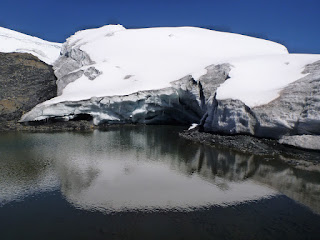I visited another archeology museum this morning. They explained something I had already seen, but not understood, in yesterday's museum: whistling bottles. This is one of them:

These bottles have two holes. A big one to fill or empty the bottle, and a small one hidden somewhere. In the picture above, it is just below the chin of the figurine. Now, when the bottle is filled or emptied, air goes out (or in) through the small hole, and this creates a whistling sound. Fascinating!
Next to whistling bottles, the museum also had a collection of other musical instruments, like these flutes made from bone:

The last room of the museum was dedicated to gold work, or orfebrería in Spanish (I love learning strange new words). What made this part particularly interesting was that they not only showed various pieces of jewelry, but also explained how these had been worn by putting old clay statues next to the gold exhibits.
Finally, there a few golden death masks on display, like this one:

Beautiful work, isn't it?
In the afternoon, I got together with two of my CELTA course mates. Seems I got lucky there again: at least with these two, I'll get along very well :-)

These bottles have two holes. A big one to fill or empty the bottle, and a small one hidden somewhere. In the picture above, it is just below the chin of the figurine. Now, when the bottle is filled or emptied, air goes out (or in) through the small hole, and this creates a whistling sound. Fascinating!
Next to whistling bottles, the museum also had a collection of other musical instruments, like these flutes made from bone:

The last room of the museum was dedicated to gold work, or orfebrería in Spanish (I love learning strange new words). What made this part particularly interesting was that they not only showed various pieces of jewelry, but also explained how these had been worn by putting old clay statues next to the gold exhibits.
Finally, there a few golden death masks on display, like this one:

Beautiful work, isn't it?
In the afternoon, I got together with two of my CELTA course mates. Seems I got lucky there again: at least with these two, I'll get along very well :-)



















































